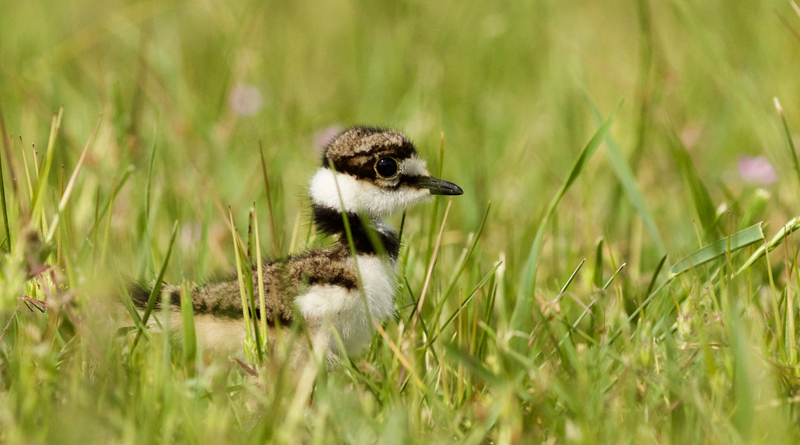KILLDEER, SHOREBIRD OF THE FIELDS – Life In The Outdoors

I was driving near home one cool, clear pleasant morning recently when I saw the birds. Two of them. They flew up from the side of the road, almost beside me, then across the road in front of me. The instant I saw them, instinctively, I stomped on the brake pedal and stopped. Had I reacted a few seconds later I would have hit the birds. They were that close.
The birds were killdeers. I recognized them as soon as I saw them. They were slightly bigger than robins with a series of black and white bands on their head and upper breast. They have a black band across their forehead, white in front of the eyes, another black band from the bill back on the sides of the head, then more white. They have another black band around their throat, like a necklace, and another across the upper breast.
Killdeers are brown on top of the head and back. They’re brown and black on their back, wings and tail and their belly and under tail coverts are white. No other bird has that combination of black, white and brown.
A killdeer’s lower back and rump are rich reddish brown. No other bird has that color trait either. Male and female killdeers look alike. They wear the same colors.
Killdeers have somewhat plump bodies, short, pigeon-like bills, short legs for a bird their size and long pointed wings. Killdeers are classified as plovers, shore birds, but they don’t feed along shores. They feed on the ground, dry, grassy uplands not shorelines or waterways.
In my car with the windows closed I didn’t hear the killdeers but if I had heard them they would have told me what they were. They have a loud, strident call, kill-deer, kill-deer, kill-deer or kill-dee, kill-dee, kill-dee. At times they shorten their call to dee, dee, dee.
Killdeers eat grubs, worms and various bugs. They eat fleas, ticks, grasshoppers, weevils, wire-worms, click beetles and horse flies, almost anything edible they can scavenge. Their diet makes them welcome birds to farmers and gardeners.
Killdeers feed on the ground and they nest on the ground. Their nests are simply scrapes, slightly cleared patches. I’ve found them in short grass, in driveways and in stony rubble. A pair used to nest in our pasture but that was several years ago. One year killdeer made a nest at the base of the post for our mailbox. Their eggs are spotted and blend in with their surroundings.
Killdeers try to protect their nests but not by belligerence, not by calling, threatening to attack or diving at an intruder, striking the intruder as many birds do. They try to lure an intruder away by crying piteously, fluttering away from the nest dragging one wing as if it was broken, even dragging both wings.
Killdeers, like many other birds, brown thrashers, catbirds, yellow warblers, flycatchers and many more, have declined in number. I used to see them almost any time I went driving or walking in the country. I saw them for a number of years every day I walked out in our pasture. Now to see a killdeer is a special sighting, like seeing a shrike or other uncommon bird in the area where I live and over much of its former spring, summer and fall territory.
I was pleased to see the two killdeers that up flew beside me, then across the road in front of me. I was pleased and hit the brakes as soon as I saw them and that I managed to stop before I hit them. And I was pleased there wasn’t another car close behind me when I hit the brakes. It might have hit me and driven me into hitting those killdeers.
- Birds As Weather Forecasters – Life In The Outdoors - December 17, 2021
- Rare Bird Spotted In Indiana – Life In The Outdoors - October 8, 2021
- MY EXPERIENCE WITH DEER – Life In The Outdoors - July 30, 2021


